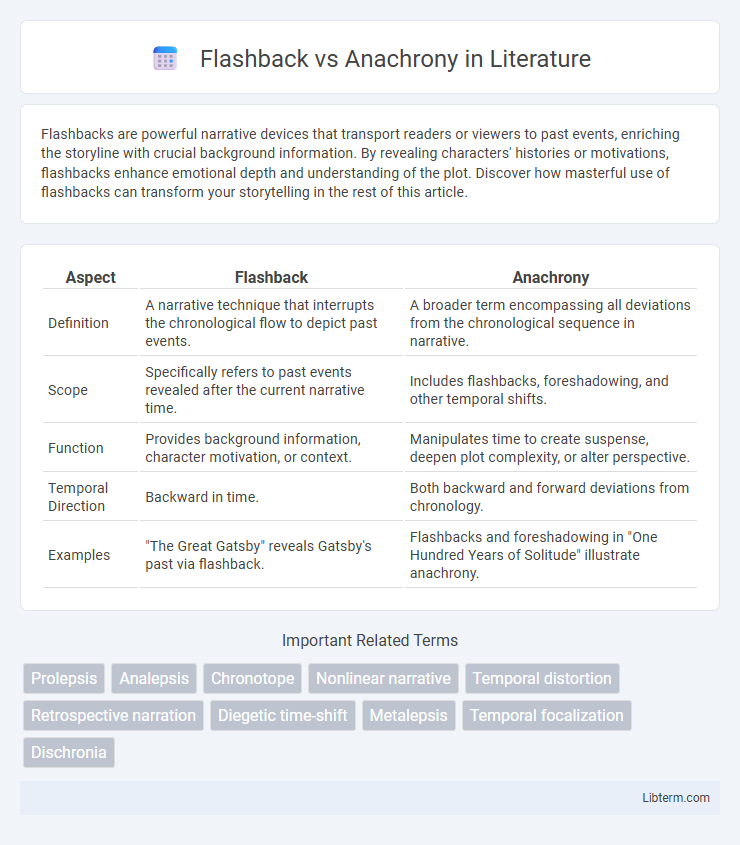Flashbacks are powerful narrative devices that transport readers or viewers to past events, enriching the storyline with crucial background information. By revealing characters' histories or motivations, flashbacks enhance emotional depth and understanding of the plot. Discover how masterful use of flashbacks can transform your storytelling in the rest of this article.
Table of Comparison
| Aspect | Flashback | Anachrony |
|---|---|---|
| Definition | A narrative technique that interrupts the chronological flow to depict past events. | A broader term encompassing all deviations from the chronological sequence in narrative. |
| Scope | Specifically refers to past events revealed after the current narrative time. | Includes flashbacks, foreshadowing, and other temporal shifts. |
| Function | Provides background information, character motivation, or context. | Manipulates time to create suspense, deepen plot complexity, or alter perspective. |
| Temporal Direction | Backward in time. | Both backward and forward deviations from chronology. |
| Examples | "The Great Gatsby" reveals Gatsby's past via flashback. | Flashbacks and foreshadowing in "One Hundred Years of Solitude" illustrate anachrony. |
Introduction to Flashback and Anachrony
Flashback is a narrative technique that interrupts the chronological sequence of events to depict earlier occurrences, providing background or context to the current story. Anachrony, a broader concept within narratology, refers to any disruption in the natural temporal order of a narrative, encompassing both flashbacks (retrospective anachrony) and flashforwards (prospective anachrony). Understanding flashback as a specific type of anachrony helps clarify how time manipulation enhances storytelling by revealing crucial past details.
Defining Flashback in Narrative Structure
Flashback in narrative structure is a technique that interrupts the chronological flow of a story to depict events that occurred earlier in the timeline, providing context and background information. Anachrony encompasses all deviations from chronological order, including flashbacks and flashforwards, making flashback a specific type of anachrony. This device enhances character development and plot depth by revealing past experiences influencing current events.
Understanding Anachrony: Beyond the Flashback
Anachrony encompasses all narrative disruptions in the chronological order of events, including flashbacks and flashforwards, allowing stories to reveal past or future information out of sequence. Understanding anachrony involves recognizing how these temporal shifts create deeper layers of meaning, character development, and plot complexity beyond simple flashback use. This narrative technique enriches storytelling by manipulating time, challenging readers to piece together a non-linear timeline and enhancing engagement with the text's temporal structure.
Key Differences Between Flashback and Anachrony
Flashback refers to a narrative technique where the chronological order is interrupted to present past events, enhancing character background and plot depth. Anachrony encompasses flashback and flashforward, involving any temporal displacement that deviates from chronological sequence to create meaning or suspense. The key difference lies in scope: flashback specifically revisits past moments, while anachrony includes all non-linear time shifts within a story's timeline.
Types of Anachrony in Literature and Film
Flashback is a common form of anachrony, characterized by a narrative interruption that shifts the timeline to a previous event, often used in literature and film to reveal crucial backstory and enhance character development. Types of anachrony include flashbacks, flashforwards, and prolepses, each manipulating narrative time to create suspense or deepen thematic complexity. These temporal deviations break the chronological order, allowing creators to explore perspectives and information inaccessible through linear storytelling.
The Functions of Flashbacks in Storytelling
Flashbacks function as deliberate narrative devices that provide essential backstory, deepen character development, and clarify plot motivations by revealing past events that influence present actions. Unlike anachrony, which broadly encompasses any deviation from chronological order, flashbacks specifically retrace prior moments to enrich the storyline and create emotional resonance. Employing flashbacks enhances thematic depth and allows storytellers to manipulate time to underscore cause-and-effect relationships within the narrative structure.
Creative Uses of Anachrony for Plot Development
Anachrony, a narrative technique involving non-linear timelines, creatively enriches plot development by revealing character motivations and backstory through strategically placed flashbacks or flashforwards. Unlike simple flashbacks, anachrony manipulates temporal order to build suspense, deepen thematic complexity, and intertwine multiple story arcs seamlessly. This temporal distortion encourages active audience engagement and heightens emotional impact by gradually unveiling critical information out of chronological sequence.
Common Pitfalls When Employing Nonlinear Narratives
Common pitfalls in using flashbacks versus anachrony in nonlinear narratives include confusing temporal shifts that disrupt reader comprehension and diminish narrative coherence. Flashbacks, which specifically refer to scenes depicting past events, require clear contextual cues to avoid temporal disorientation, while anachrony encompasses broader temporal manipulations like flashforwards or reordered chronology, demanding precise structural planning. Failure to maintain consistent temporal markers or overuse nonlinear elements can lead to disjointed storytelling and reduced emotional impact.
Flashbacks vs. Analepsis and Prolepsis
Flashbacks, synonymous with analepsis, involve a narrative technique where past events are recounted to provide context or background within a story, disrupting chronological order. Prolepsis, or flashforward, contrasts this by projecting future events, creating anticipation or foreshadowing. Both analepsis and prolepsis manipulate timeline sequences to enrich storytelling and deepen the audience's understanding of character development or plot progression.
Choosing the Right Technique for Your Story
Choosing between flashback and anachrony depends on how you want to manipulate narrative time and structure. Flashbacks provide direct scenes from the past to reveal character motivations or background, enhancing emotional depth without disrupting linear progression. Anachrony, encompassing all non-chronological storytelling techniques, allows for complex temporal shifts that can create mystery, suspense, or thematic resonance essential for experimental or layered narratives.
Flashback Infographic

 libterm.com
libterm.com